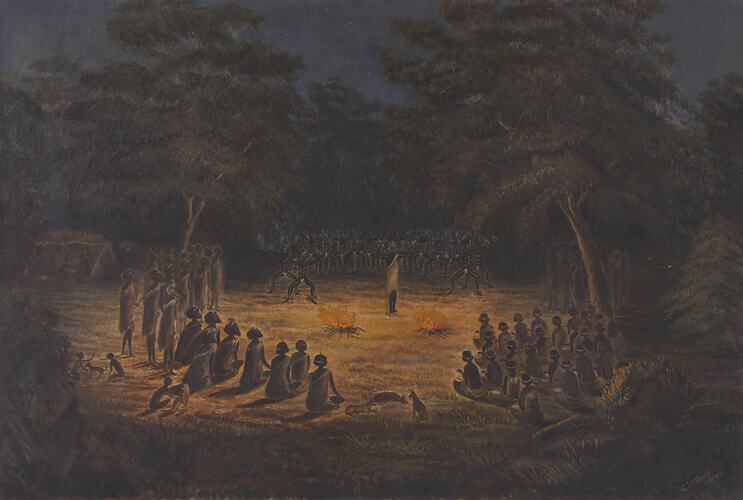Summary
'Corroboree on the Goulburn River' painted by artist Caroline Le Souëf in early 1895. The painting depicts a corroboree of the Bangarang (spelt by Le Souëf as Pangarang) tribe in December 1842 as witnessed and later described by Caroline's husband Albert. It depicts dance and ceremony taking place, groups to the sides are wearing their possum skin cloaks and the men dancing in the middle are painted for ceremony. It is probable that the event depicted in this painting preceded the fight depicted in one of Caroline's other paintings titled 'Native Fight on the Lower Goulburn River in 1842'.
The events depicted in the painting took place on the site of what is today Murchison on the Goulburn River in Victoria, with the onlookers in the painting being members of the Oorilim tribe. The painting depicts the dancers just before the final rush which Albert describes: 'the dancing now ceased, and the men rushing into a compact body, stamped with their right feet until a cloud of dust arose, when with a sudden yell, each man threw his arms above his head, and they then retired into the gloom, to commence again.'
The Le Souëf family had close relationships to the Victorian Aboriginal communities in the Goulburn area. Caroline grew-up in friendly contact with the local Aboriginal people of the Goulburn River Valley region, and developed an ongoing interest in their life and customs. Later in life she took up oil painting of Aboriginal subjects - reminiscences from her and her husband's youth. During his teenage years Caroline's husband Albert A. Le Souëf had spent three years at the Goulburn River protectorate station, managed by his father, where he gained lasting knowledge of Aboriginal culture and bushcraft.
Physical Description
Oils on canvas, depicting a dance scene at night. Titled 'Corroboree on the Goulburn River'. Signed and dated 27/2/1895.
More Information
-
Object/Medium
Painting
-
Maker
-
Locality
-
Date Produced
-
Framed
1318 mm (Width), 65 mm (Depth), 955 mm (Height)
External dimensions of frame
-
Keywords
-
Type of item
-
Discipline
-
Category
-
Collecting Areas


